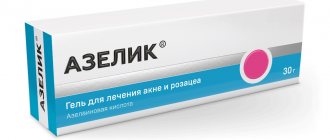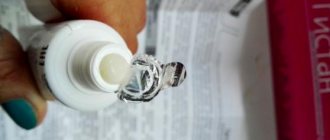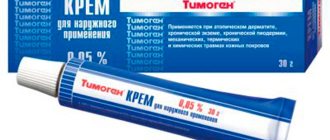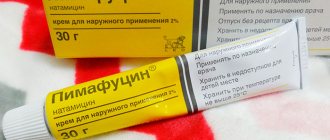General characteristics
The agent in question has bacteriostatic properties: its mechanism of action is the ability to suppress protein synthesis of pathogen cells. When high concentrations are created in affected tissues, the drug causes the death of a number of microorganisms (it has a bactericidal effect).
The spectrum of activity of Clindamycin cream covers the main strains of bacterial vaginosis pathogens, including:
- facultative anaerobes Gardnerella vaginalis;
- gram-positive rod-shaped Mobiluncus spp.;
- non-spore-forming Peptostreptococcus spp.;
- gram-negative Bacteroides spp.;
- anucleate Mycoplasma hominis.
The above infectious agents are classified as opportunistic and are part of the microbiocenosis of the urogenital tract.
The product is not used in the fight against trichomonas, candida, and fungi.
pharmachologic effect
Clindamycin cream is considered a broad-spectrum drug directed against most strains of microorganisms. Its therapeutic effect is based on the suppression of protein compounds in infected cells. As a result of exposure, the focus of the inflammatory process loses its aggressiveness and further development of the disease stops. The use of the cream slows down the development of pathogenic microorganisms due to the penetration of the active substance into the infected cell and suppression of protein synthesis in it. As a result, the microorganism becomes unable to further develop.
Clindamycin has a bacteriostatic effect on the affected area. Its antibacterial effect is effective against aerobic and anaerobic microorganisms (except for the bacterium F. Varium), as well as in the case of allergic reactions to the use of penicillin antibiotics.
The drug has the ability to be quickly absorbed through the mucous membranes of the gastrointestinal tract. Simultaneous food intake significantly slows down the absorption of the medicinal substance, although its concentration in the blood plasma remains unchanged.
The highest concentration of the drug is observed on average within an hour. The half-life of the main substance from the body is 2.5 hours, and it is completely eliminated from the body only in four days. Considering this, when using a cream containing clindamycin, one should keep in mind the possibility of diarrhea. If such symptoms do not disappear within two days, the drug is discontinued.
Packaging of the medicine, its components
Clindamycin cream is dispensed in tubes made of aluminum. The weight of the containers is 40 and 20 grams. Each package contains an annotation and is equipped with an applicator.
The basis of the drug is water-soluble Clindamycin phosphate. The additional components are sodium benzoate, castor oil, propylene glycol. The connecting link is macrogol 1500.
The color of the cream varies from pale yellow to white; the product has a specific odor.
It should be noted that the described form of release is used only for the purpose of relieving the symptoms of vaginosis.
To prevent the development of other groups of diseases, pharmaceutical companies offer consumers lincosamide Clindamycin in the form of tablets, injection solution, and gel. Read more about the different types of medication in the table below.
| Release form | Application | Description |
| Pills | Consumed orally; are used primarily for infections of the ENT organs, respiratory tract, and abdominal cavity. | Purple capsules with different contents of the active substance (Clindamycin hydrochloride). Packed in blisters. |
| Solution | It is used intravenously, intramuscularly in severe cases of the above types of ailments. | A transparent liquid containing the active ingredient in the form of phosphate. Available in ampoules with a capacity of 2, 4, 6 ml. |
| Gel | Apply to the skin to treat acne. | Liniment of uniform consistency. It has a white color and a faint aroma. Sold in tubes. |
In addition to these forms, the medical product is also available in the form of suppositories containing 100 mg of the antibiotic lincosamide phosphate. Suppositories, like cream, are administered intravaginally; are used to prevent inflammation of the vaginal mucosa, in preparation for gynecological manipulations, in order to suppress infectious diseases of the genitourinary system.
Instructions for use
According to the annotation for the drug, 2% Clindamycin ointment is used for vaginosis, the development of which is provoked by various types of bacteria and is a consequence of a violation of the quantitative composition of the microflora of the vaginal environment.
Among the signs of the disease, the relief of which requires the use of the antibiotic lincosamide:
- copious discharge, the color of which varies depending on the duration of the disease from white to grayish and yellow;
- leucorrhoea has an unpleasant odor;
- discomfort during sexual intercourse;
- burning;
- itching;
- urinary disorders.
When diagnosing vaginal dysbiosis, the presence of pathogens is determined by examining the patient's smear.
Before prescribing the drug, laboratory tests exclude the presence of chlamydia, trichomonas vaginalis, yeast-like fungi of the genus Candida, gonococci, and herpes simplex viruses that cause vulvovaginitis.
- Clandymicin B prolong - instructions;
- Datsalin - instructions;
- Antibiotics for pharyngitis - .
Indications for use of the cream
Due to the fact that Clindamycin cream is a drug with antibacterial properties, the greatest effect when using it can be obtained in the treatment of inflammatory processes of the vagina caused by a bacterial infection, namely bacterial vaginosis. In this disease, as a result of further development of the infectious process, the natural lactoflora of the vagina is replaced by aggressive pathological microflora.
For example, this remedy is used to treat vaginosis, the characteristic symptoms of which are copious discharge with an unpleasant odor. To diagnose the presence of vaginosis, a vaginal smear is examined, which can reveal the presence of pathogenic microflora and serve as a reason for treatment with Clindamycin cream.
Before you start using the drug, you must keep in mind the contraindications, which are as follows:
- the patient's age is under 18 years;
- individual intolerance to the active substance clindamycin or one of the auxiliary components of the cream;
- pregnancy in the first trimester;
- breastfeeding period.
The use of Clindamycin cream is prescribed for vaginal infections caused by certain types of staphylococci and streptococci. During treatment, it is necessary to take into account that in the case of existing microorganisms that are insensitive to the drug, namely yeast-like fungi, the effect of Clindamycin cream can provoke their increased development.
Contraindications, overdose
Clindamycin in the form of a cream is not used in treatment regimens for patients under 18 years of age, or if the woman has a history of individual intolerance to antibiotics - representatives of the lincosamide class.
There is no information about an overdose of the drug in the medical literature.
If vaginal cream accidentally gets into the gastrointestinal tract, the following may occur:
- epigastric pain;
- attacks of nausea, vomiting;
- esophagitis;
- back discomfort;
- liver dysfunction (including hyperbilirubinemia);
- dysbiosis.
To alleviate the patient's condition, symptomatic, supportive therapy is used.
Existing analogues
Clindamycin cream has several analogues that have the same composition and are prescribed for the same diseases.
- Dalacin is a cream based on a product similar in composition. It has an antibacterial effect and is used to treat vaginitis caused by bacteria. Effectively eliminates symptoms of pathology and foci of infection.
- Clindacin is a cream used for vaginosis. The basis of this product is clindamycin phosphate. It is not used for persons under the age of majority; it has a number of contraindications.
- Vagitsin is a cream whose main active ingredient is clindamycin phosphate. Has an antibacterial effect. Contraindicated for use in the presence of inflammatory processes in the intestines and colitis resulting from taking antibiotics.
Clindamycin cream, due to its antibacterial properties, has proven effective against various pathological microflora. Among similar drugs, it is most popular due to its unique properties.
Use during pregnancy and lactation
Studies on the effect of the drug in question on fetal development when used intravaginally in the first trimester of gestation have not been performed. According to experts, the drug should be prescribed in the early stages of pregnancy only when absolutely indicated (in cases where the benefit of antibiotic therapy for the woman outweighs the risk of pathologies in the fetus).
In the second and third trimesters, a negative impact of a medical product on a child during a woman’s treatment seems unlikely.
According to available data, about 3% of Clindamycin in cream form is subject to systemic absorption. Experts have not studied the ability of liniment to penetrate into breast milk, but since drug concentrations were detected in the latter after oral and parenteral administration, it is recommended to stop breastfeeding for the period of therapy.
Terms of use
Ointment (cream) Clindamycin, according to the data given in the annotation for the product, is administered after hygiene procedures, before bedtime, 1 time per day.
Manipulations are carried out using an applicator
The algorithm for carrying them out consists of 4 steps:
- The cap is removed from the tube, and a special device for dosing the medication is attached to its neck.
- The applicator is filled by gently pressing the antibiotic container. Actions should be stopped after the piston reaches the stop - the latter indicates 100% filling of the device.
- The device is removed from the container. The tube is closed with a cap.
- The applicator is inserted into the vagina to the maximum possible depth. By pressing the plunger the cream is applied to the affected area.
- The empty device is carefully removed.
The procedure should not cause discomfort or pain. The patient should be manipulated while lying on her back, with her legs bent at the knees and pulled up to her chest.
The drug is prescribed in a course, the duration of which is from 3 days to one week. The recommended single dose is five grams of medication (full applicator).
The duration of therapy can be shortened or increased by a specialist depending on the general condition of the patient and the severity of the disease.
Side effects
Like any antibiotic, Clindamycin in cream form can negatively affect the body. Instructions for use of the product contain information about the development of negative effects, including:
- Disorders of the endocrine system, expressed in hyperthyroidism.
- Manifestation of disruptions in the functioning of the digestive tract. Symptoms include constipation or diarrhea, flatulence, nausea, vomiting, and severe cramps. Possible bad breath and taste distortion. Long-term therapy can cause the development of dysbiosis and hypovitaminosis. At the first symptoms of loose stools, it is recommended to discontinue the drug.
- The occurrence of headaches, dizziness, nosebleeds, abnormalities in the blood picture.
- On the part of the genitourinary system, the side effect of vaginal cream manifests itself in the form of vulvovaginitis, menstrual irregularities, endometriosis, vaginal discomfort, and uterine bleeding.
In addition to these effects, there have also been cases of rash, erythema, and itching on the skin at the injection site.
Among the general systemic changes, the appearance of inflammatory edema, allergic reactions, and the development of fungal infections was recorded.
The incidence of all considered types of negative effects of Clindamycin does not exceed 10% of the total number of all examined patients.
Description of the drug
Clindamycin is a white thick cream with a yellowish tint and a specific odor. An hour after insertion into the vagina, the maximum therapeutic concentration of the antibiotic is created in pathological foci. And after a few minutes there is a decrease in the severity of clinical manifestations. The drug is used in the treatment of both acute and chronic bacterial vaginosis. By including it in therapeutic regimens, gynecologists pursue several goals:
- weakening of symptoms - reduction in the volume of vaginal discharge, elimination of itching and a feeling of dryness;
- destruction of pathogenic and conditionally pathogenic bacteria that provoke the development of pathology;
- creating an environment favorable for increasing the number of beneficial lacto- and bifidobacteria;
- preventing the spread of the disease to healthy tissue.
In addition to cream, the Clindamycin therapeutic line includes gel, capsules, and solution for parenteral administration. All dosage forms are used to treat pathologies that arise due to the introduction of pathogenic bacteria into the body.
Clindamycin gel is used in dermatology for acne and acne. When purchasing, you should explain to the pharmacist why the external remedy is needed. Cream and gel are not interchangeable; they are intended for the treatment of various pathologies.
Clinical and pharmacological group
Clindamycin is a representative of the clinical and pharmacological group of bacteriostatic drugs for external use. The ointment is a product used in the treatment of gynecological pathologies.
pharmachologic effect
The active ingredient of the drug is a semisynthetic antibiotic of the lincosamide group, clindamycin. It has a fairly narrow spectrum of bacteriostatic activity. Clindamycin is usually used in the treatment of vaginitis caused by non-spore-forming anaerobes and gram-positive cocci. The drug is characterized by the following mechanism of pharmacological action:
- upon contact with a bacterial cell, the antibiotic binds to certain RNA links;
- this leads to disruption of the biosynthesis of proteins necessary for the construction of membranes;
- reproduction of microorganisms becomes impossible, so they soon die.
Immediately after inhibition of activated representatives of opportunistic microflora, regeneration processes are launched. The number of lactobacilli, which create an acidic environment in the vagina, is gradually restored. Now the growth of microbes is naturally controlled, and painful symptoms quickly disappear.
Release form and composition
In pharmacies you can buy domestic and imported (Serbia) Clindamycin. It is packaged in 20 and 40 g in aluminum sealed tubes. Each of them is enclosed in a cardboard box along with instructions for use. The secondary packaging also contains an applicator for convenient intravaginal administration of the drug. The active ingredient in Clindamycin ointment is clindamycin phosphate. The auxiliary composition is represented by the following components:
- macrogol;
- castor oil;
- sodium benzoate;
- propylene glycol;
- emulsifier.
Additional ingredients perform not only the functions of stabilizers and preservatives. They ensure rapid absorption and transformation of clindamycin phosphate and its distribution in pathological foci.
Auxiliary ingredients prolong and enhance the effect of the antibiotic. Propylene glycol has weak antiseptic properties, and castor oil eliminates burning, itching, and dry mucous membranes.
Storage conditions and periods
The cream is intended for storage in places protected from sunlight, at a temperature not exceeding 20°C. The shelf life of Clindamycin is 24 months, after opening the aluminum tube - 4-5 weeks. Freezing of the medicine is not allowed. Damage to the cream is indicated by its separation, change in color and (or) smell. The access of small children to the place where the drug is stored should be limited.
special instructions
It is prohibited to use Clindamycin cream without a doctor’s prescription: inadequate therapy can provoke the development of serious complications and a deterioration in the patient’s general condition.
The use of antibiotics in combination with other medications has a number of features. First of all, it should be noted that doctors do not recommend the use of other medications administered intravaginally. It is not advisable to include vaginal rinsing with solutions of medical products, or douching, in treatment regimens.
In addition to the above, it was revealed:
- cross-resistance of the antibacterial agent in question with lincomycin;
- antagonism (significant weakening of the pharmacotherapeutic effect) with erythromycin in vitro.
With caution and only under the supervision of a doctor, it is necessary to use the drug cream in conjunction with general anesthetics, aminoglycosides, and narcotic analgesics, since the oral form of Clindamycin increases the side effects of these drugs on the body.
You should also take into account the incompatibility of the antibiotic solution with B vitamins and ampicillin.
During treatment, it is strongly recommended to abstain from sexual intercourse.
It is also necessary to take into account the fact that additional components of the medication are substances that can reduce the strength of contraceptive diaphragms and latex condoms.
No studies have been conducted on the effect of Clindamycin ointment on the ability of women to drive vehicles or operate machinery; There is no reason to believe that the drug reduces the level of concentration.











